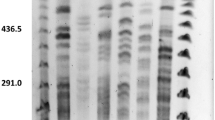Abstract
We have investigated the value of rRNA gene restriction (rDNA) patterns for strain discrimination in aeromonads isolated from clinical and environmental sources. Chromosomal DNA was purified and digested with restriction enzymesPst I andSma I, and the resulting fragments were separated by agarose gel electrophoresis and stained with ethidium bromide. The DNA was transferred to membranes (Southern blotting), where it was probed with biotinylated plasmid pKK3535 DNA. Hybridization bands were developed with the BluGene (BRL) kit. The resulting rDNA patterns were visually analyzed for similarities between epidemiologically related strains. Pattern heterogeneity was observed among unrelated strains of aeromonads of clinical and environmental origin, whereas homology was observed amongAeromonas caviae isolates from three siblings with gastroenteritis and between an infant and foster mother with acute gastroenteritis caused byA. caviae. Multiple isolates ofA. caviae from the same patient over more than 3 years produced homologous rDNA patterns which remained stable after 20 consecutive subcultures. Serotyping results for typable strains were consistent with strain designations derived by analysis of rDNA patterns. The specificity, reproducibility, stability, and ease of performance, especially with the nonisotopic probe, make ribotyping a valuable method for epidemiological investigations ofAeromonas infections.
Similar content being viewed by others
Literature Cited
Altwegg M, Geiss H-K (1989)Aeromonas as a human pathogen. CRC Crit Rev Microbiol 16:253–286
Altwegg M, Mayer LW (1989) Bacterial molecular epidemiology based on a nonradioactive probe complementary to ribosomal RNA. Res Microbiol 140:325–333
Altwegg M, Altwegg-Bissig R, Demarta A, Peduzzi R, Reeves MW, Swaminathon B (1988) Comparison of four typing methods for Aeromonas species. J Diarrheal Dis Res 6:88–94
Altwegg M, Martinetti LG, Lüthy-Hotenstein J, Rohrbach M (1991)Aeromonas-associated gastroenteritis after consumption of contaminated shrimp. Eur J Clin Microbiol Infect Dis 10:44–45
Brosius J, Ullrich A, Raker MA, Gray A, Dull TJ, Gutell RR, Noller HF (1981) Construction and fine mapping of recombinant plasmids containing the rrnB ribosomal RNA operon ofE. coli. Plasmid 6:112–118
Chang BJ, Bolton SM (1987) Plasmids and resistance to antimicrobial agents inAeromonas sobria andAeromonas hydrophila clinical isolates. Antimicrob Agents Chemother 31:1281–1282
Grimont F, Grimont PAD (1986) Ribosomal ribonucleic acid gene restriction patterns as potential taxonomic tools. Ann Inst Pasteur/Microbiol 137B:165–175
Janda JM, Dixon A, Raucher B, Clark RB, Bottone EJ (1884) Value of blood agar for primary plating and clinical implication of simultaneous isolation ofAeromonas hydrophila andAeromonas caviae from a patient with gastroenteritis. J Clin Microbiol 20:1221–1222
Joseph SW, Daily OP, Hunt WS, Seidler RJ, Allen DA, Colwell RR (1979)Aeromonas primary wound infection of a diver in polluted water. J Clin Microbiol 10:46–49
Joseph SW, Carnahan AM, Brayton PR, Fanning GR, Almazan R, Drabick C, Trudo EW, Colwell RR (1991)Aeromonas jandaei andAeromonas veronii dual infection of a human wound following aquatic exposure. J Clin Microbiol 29:565–569
Kuijper EJ, van Alphen L, Leenders E, Zanen HC (1989) Typing ofAeromonas strains by DNA restriction endonuclease analysis and polyacrylamide gel electrophoresis of cell envelopes. J Clin Microbiol 27:1280–1285
Martinetti G, Altwegg M (1990) rRNA gene restriction patterns and plasmid analysis as a tool for typingSalmonella enteritidis. Res Microbiol 141:1151–1162
Martinetti LB, Altwegg M Ribosomal RNA gene restriction patterns as taxonomic tools in the genusAeromonas. In preparation
Picard B, Goullet P (1987) Epidemiological complexity of hospitalAeromonas infections revealed by electrophoretic typing of esterases. Epidemiol Infect 98:5–14
Sakazaki R, Shimada T (1984) O-Serogrouping for mesophilicAeromonas strains. Jpn J Med Sci 37:247–255
Stull TL, LiPuma JJ, Edlind TD (1988) A broad-spectrum probe for molecular epidemiology of bacteria: ribosomal RNA. Res Microbiol 141:1151–1162
Thomas LV, Gross RJ, Cheasty T, Rowe B (1990) Extended serogrouping scheme for motile, mesophilicAeromonas species. J Clin Microbiol 28:980–984
Author information
Authors and Affiliations
Rights and permissions
About this article
Cite this article
Moyer, N.P., Martinetti, G., Lüthy-Hottenstein, J. et al. Value of rRNA gene restriction patterns ofAeromonas spp. for epidemiological investigations. Current Microbiology 24, 15–21 (1992). https://doi.org/10.1007/BF01570094
Issue Date:
DOI: https://doi.org/10.1007/BF01570094




